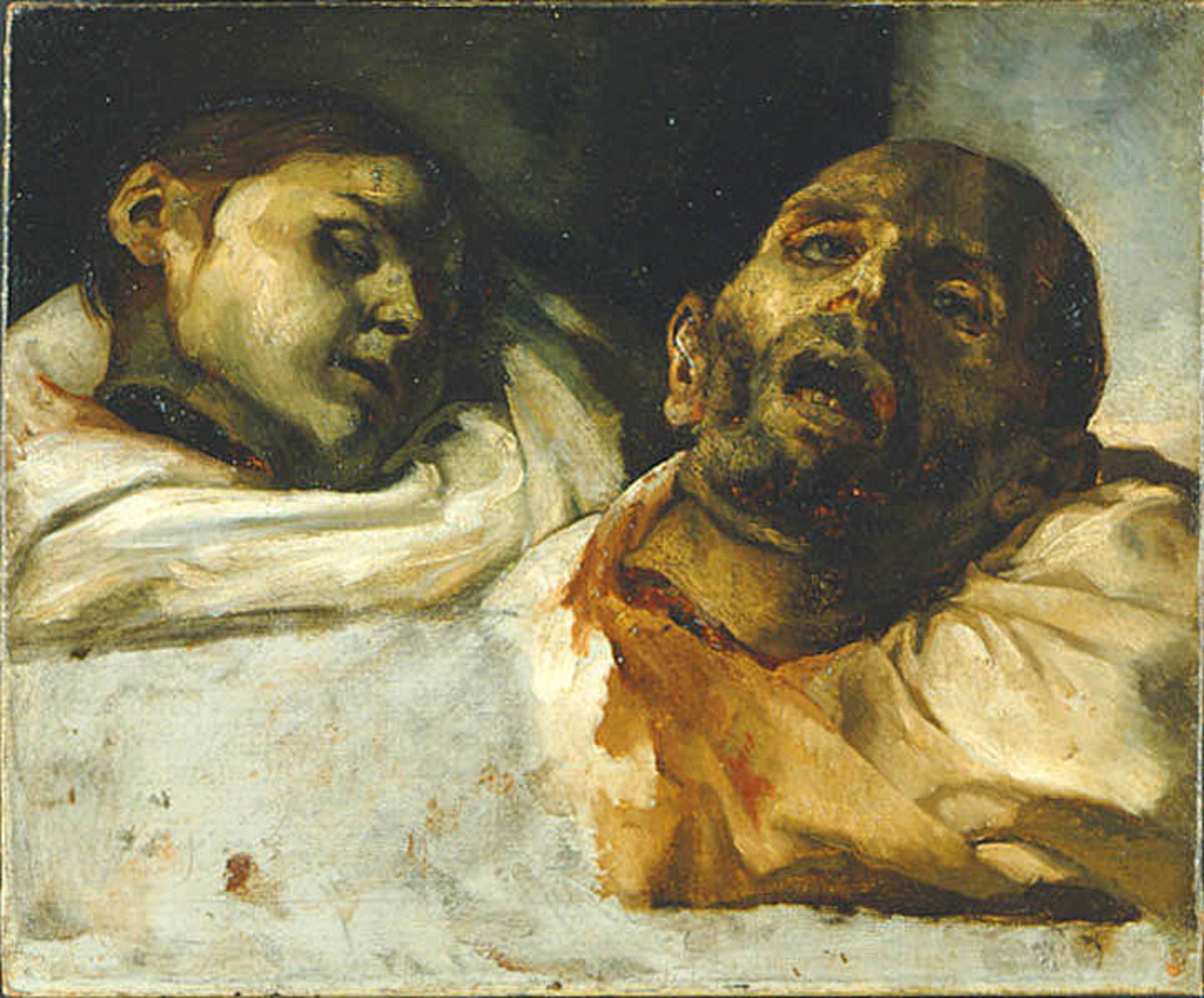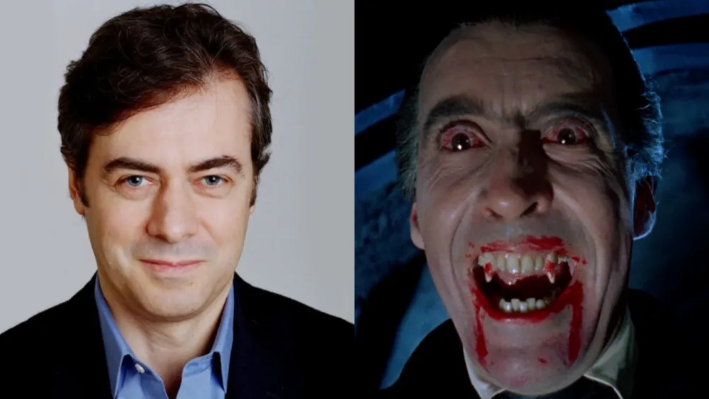1. Untitled Painting (1984) - Zdzislaw Beksinski
 © Wikimedia Commons
© Wikimedia Commons
Specialising in the field of dystopian surrealism, Polish born artist Zdzislaw Beksinski has drawn comparisons with fellow artist and contemporary H.R. Giger for his darkly fantastical and incredibly detailed compositions (often epic and architecturally complex landscapes). Untitled Painting however, conveys an intimate scene, of two skeletons entwined in a melancholy embrace reminiscent of Rodin's The Kiss.
In his own words: "I wish to paint in such a manner as if I were photographing dreams".
2. Little Electric Chair (1964) - Andy Warhol
 © Tumblr
© Tumblr
In 1963, in an artistic period which had already seen him begin a series of silk-screened paintings of death, disasters and tragedy-stricken celebrities, Andy Warhol produced numerous groups of silk-screens of an electric chair. The first of these coincided with New York's Sing Sing State Penitentiary's last two executions by electric chair, and thus the paintings helped fuel the ensuing national debate about the death penalty.
Warhol was quick to deny engaging in any kind of social critique however, claiming "no meaning, no meaning" when asked about the project.
3. Gallowgate Lard (1995-96) - Ken Currie
 © BBC
© BBC
Inspired by his own working class upbringing in North Shields, and an examination of the brutality and poverty of urban life during his time in Scotland, Glasgow School of Art graduate Ken Currie's work often explores grim social-realist subjects.
Gallowgate Lard is referred to by Currie as a kind of self portrait. But more than that - as the Aberdeen Art Gallery & Museums (which houses the painting) puts it - "[Gallowgate Lard] is a comment on life itself; not the more usually depicted pleasant aspects of life, but as Currie sees it and has always seen it - a struggle for survival."
4. The Temptation of St. Anthony (1512-15) - Matthias Grünewald
 © WikiArt
© WikiArt
Acclaimed as the greatest German Renaissance artist, Matthias Grünewald's masterpiece is widely considered to be the Isenheim Altarpiece (painted in collaboration with fellow German Niclaus of Haguenau), which is made up of a number of panels including The Temptation of St Anthony. This panel, part of the altarpiece's Third View, depicts St Anthony lying on his back, appealing to God while being attacked and trampled by a horde of demons.
5. Study after Velázquez's Portrait of Pope Innocent X (1953) - Francis Bacon
 © Wikimedia Commons
© Wikimedia Commons
Francis Bacon - or as Margaret Thatcher once referred to him 'The man who paints those dreadful figures' - was a former interior decorator and gambler from Dublin who, without any formal artistic education, moved to London to begin a career as a painter (and subsequently became one of the most talked about artists of the twentieth century).
His painting Study after Velázquez's Portrait of Pope Innocent X remains one of Bacon's most revered - and chilling - to date. Based on Velázquez's Portrait of Pope Innocent X, Bacon's work has been described by many as a terrifying mirror-image, or "photo-negative" version of the original.
In his own words - "In my case all painting... is an accident. I foresee it and yet I hardly ever carry it out as I foresee it. It transforms itself by the actual paint."
6. Deterioration of Mind Over Matter (1973) - Otto Rapp
 © Fine Art America
© Fine Art America
A stomach-churning image of a decomposing human head impaled on what one can only assume is a birdcage, its tongue/innards lying in a limp pile at the cage's base, this surreal work by Otto Rapp feels at once unsettling and oddly sad. The one living eye of the subject, the skin tissue hanging from it almost a teardrop, gazes forlornly at the onlooker, aware of its own ghastly appearance yet helpless to alter it.
7. The Severed Heads (1818) - Théodore Géricault
 © Tate
© Tate
Perhaps most famous for his Raft of the Medusa, Théodore Géricault was also known for his collection of works depicting disembodied heads and limbs post-mortem. Apparently Géricault would check out the body parts from the Paris Morgue in a manner more befitting of library books, before taking them home to paint.
Art historian Paul Koudounaris commented - "Géricault [...] became increasingly interested in the naturalistic rendering of distressed anatomy, and started making frequent trips to morgues - in particular, that of the Hospital Beaujon in Paris. Initially these trips were intended simply to sketch body parts, but Géricault eventually found beauty in the severed limbs and heads he was studying, and began rendering them as subjects in their own right."
8. The Smiling Spider (1881) - Odilon Redon
 © Wikimedia Commons
© Wikimedia Commons
The Smiling Spider forms part of Redon's noirs - or "black things", as the artist himself refers to the charcoal drawings and lithographs. Unsettling and sinister in its humanity, there is also something darkly playful about the work.
In his own words - 'One must respect black, nothing prostitutes it. It does not please the eye and it awakens no sensuality. It is the agent of the mind far more than the most beautiful color to the palette or prism.'
9. Judith Beheading Holofernes (1598-99) - Caravaggio
 © WikiArt
© WikiArt
As the Biblical story goes, the beautiful widow Judith seduced the Assyrian general Holofernes, got him drunk in his tent and then cut off his head. Which is reason, if any more were needed, to avoid one night stands with strangers!
Caravaggio's depiction of the scene - which has been the subject of many great artworks - is considered by many to be the most affecting because of the exact moment the artist chose to capture: when the sword first cuts the shocked Holofernes' neck.
10. Diomedes Being Eaten by his Horses (1865) - Gustave Moreau
 © WikiArt
© WikiArt
A watercolour which depicts the disturbing climax from the 8th labour of Hercules, in which the son of Zeus was ordered to capture the four flesh eating horses belonging to King Diomedes. In the painting Hercules watches in the distance while the King's horses give their former master a friendly gnawing.
11. The Flaying of the Corrupt Judge Sisamnes (1498) - Gerard David
 © WikiArt
© WikiArt
Based on a Herodotus story about a judge who accepted a bribe and delivered an unjust verdict, The Flaying of the Corrupt Judge by Gerard David could help the FBI in choosing a fitting punishment for FIFA officials, should their numerous bribery charges be proved true.
12. The Triumph of Death (1562) - Pieter Bruegel the Elder
 © Wikimedia Commons
© Wikimedia Commons
An army of skeletons cutting down humans proficiently and mercilessly over a barren, war-torn landscape. The latest season of Game of Thrones? No, it's Pieter Bruegel the Elder's The Triumph of Death! With so many horrific atrocities on show in such minute detail, you could be forgiven for missing much of the painting's nasty goings on. Take a look at this full sized representation for a better view.
13. Saturn Devouring His Son (1819-23) - Francisco Goya
 © WikiArt
© WikiArt
Based on the Greek myth of the Titan Chronus (Romanised to Saturn) who, fearing that one of his children would overthrow him, decided to eat each upon their birth, Francisco Goya's Saturn Devouring his Son was actually painted on the artist's house wall between 1820 and 1823. It remains one of Goya's most famous and disquieting works, inspiring poet Frederick Turner to write On Goya's Saturn. Here's an excerpt:
That god who stares from the picture-space
As if he - only now it's done,
The madness slaked - can recognize the face
Whose blood and brains he gulped, to be his son,
Catches the humanist's eye.
Chronus, blind time, knowing himself again
To be Kronos the wretched King,
Squirms like a frog across the void. His pain
Goya suggests in the stiff dance he's doing;
The dark shape of why
Is shadowed in the history of Spain.
The deed of sacrifice once done
Is such as never can be done again.
The naked body of the beloved son
In his sire's hand must die.
14. Mask Still Life III (1911) - Emil Nolde
 © WikiArt
© WikiArt
The German Danish expressionist Nolde's Mask Still Life III draws on his interest in non-Western cultures to create an aggressive and - to some - terrifying look at masks from different cultures; carnival masks in the painting's centre and the shrunken head of a Brazilian Yoruna Indian in the bottom right, among others.
On the painting's colouring, Nolde said - "There is silver blue, sky blue and thunder blue. Every colour holds within it a soul, which makes me happy or repels me, and which acts as a stimulus. To a person who has no art in him, colours are colours, tones tonesÖ and that is all. All their consequences for the human spirit, which range between heaven to hell, just go unnoticed."
15. Massacre of the Innocents (1611-12) - Peter Paul Rubens
 © Wikimedia Commons
© Wikimedia Commons
This chilling painting shows King Herod's sanctioned massacre of infant children in the Bible, following the Three Kings' prophecy that a King of the Jews had been born. Beautiful and gut-wrenching at the same time, the chiaroscuro of the work is said to have been strongly influenced by Caravaggio.
16. The Temptation of Saint Anthony (1645) - Salvator Rosa
 © Pictify
© Pictify
Arguably more grim and hopeless than Matthias Grünewald's depiction of this biblical story, Salvator Rosa opts to personify the evil of the legend predominantly through one horrible, nightmarish demon (with others in the background egging it on). St Anthony's attempts to ward the demon away with his holy cross look oddly futile and feeble here, with the Saint fallen, at the mercy of a merciless beast.
It's worth noting the incredibly modern appearance of the demon - painted in 1645, but which would look quite at home in a number of recent sci-fi and fantasy films.
17. Dante and Virgil in Hell (1850) - William-Adolphe Bouguereau
 © Wikimedia Commons
© Wikimedia Commons
Critic and poet Théophile Gautier was particularly complimentary of the work - "Gianni Schicchi throws himself at Capocchio, his rival, with a strange fury, and Monsieur Bouguereau depicts magnificently through muscles, nerves, tendons and teeth, the struggle between the two combatants. There is bitterness and strength in this canvas - strength, a rare quality!
18. The Examination (1998) - Wayne Barlowe
 © Wayne Barlowe
© Wayne Barlowe
Having had work appear in such high-profile films as Pacific Rim, Harry Potter and the Prisoner of Azkaban and Avatar, Wayne Barlowe's work is something you've probably seen, even if you haven't heard of the man himself. His own paintings regularly look to portray Hell, a place which Barlowe sums up thus - ìHell is characterized by its complete indifference to human suffering.î The Examination seems to echo this sentiment. with the hulking demons displaying a curiosity of their human victim, even as they disregard the pain they inflict in studying him.
Of the collection Barlowe's Inferno, Guillermo del Toro commented : 'The Devil has found an architect.'





















